A lot is possible with music theory – a system of analysis and a common vocabulary that musicians share to make communication easier. Many people want to learn how to make happier music because it’s commonly the most popular. It’s worth our time to state what chord progression is the happiest for the sake of analysis.
The happiest chord progression is the I-IV-V progression which, at one point, was also the most common progression in popular music. What makes it so happy is that it’s just the 3 major chords of the regular major scale, the tonic, the sub-dominant, and the dominant.
What Is The Happiest Chord Progression? – The I-IV-V
In the Western Music theory system, there are only 12 notes and the distance between each of them is crucial for understanding why things sound the way they do.
One essential thing to know is that semitones and whole steps define Major, Minor, and Perfect intervals. Unlike the first two, perfect intervals have no tendency to resolve to another note, which is why they have their name.
The seven notes that make up the scales in the twelve-note system also determine the degrees of the chords within a scale. The I-IV-V Roman numbers indicate the first, fourth, and fifth degrees found in the Major scales. These degrees are called tonic, sub-dominant, and dominant.
The I-IV-V progression, according to FAChords, is based on consonant intervals that are commonly used where songs begin and end. Even though minor, diminished, and augmented chord degrees provide flavour to the song, consonant major and minor chords can often succeed on their own.
The Function of the Tonic, Sub-Dominant, And Dominant
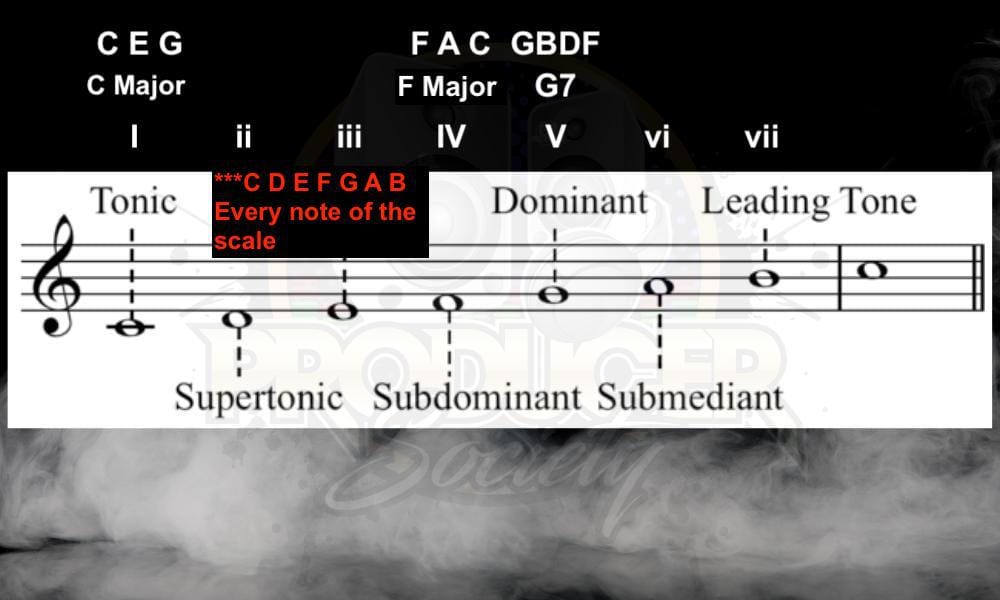
Understanding the tonic, sub-dominant, and dominant scale degrees (I-IV-V) is important for understanding why it sounds like the happiest chord progression.
In simple terms, the tonic, subdominant, and dominant harmonic functions have the tendency to lead to each other. All three of these chords contain every single note of the major scale from which they’re derived and not only that, but they don’t have any minor, diminished, or augmented intervals.
This is a big part of the reason why the I-IV-V sounds so happy. It’s a complete progression that only has major intervals. Let’s talk a bit more about that now.
Why The I-IV-V Sounds So Happy
Major chords are easily identifiable because of their cheerful, strong, and resolved sound. The significance of the I-IV-V progression in the world of pop music is understandable. Pop music is known for its emphasis on optimism and good vibes, even for softer versions.
1) The I-IV-V Is All Major Chords
![Circle of Fifths - What is the Three Chord Trick? [ANSWERED]](https://producersociety.com/wp-content/uploads/2022/04/Circle-of-Fifths-What-is-the-Three-Chord-Trick-ANSWERED.jpg)
Because it is the most effective technique to increase the Major-ness of a chord progression, the I-IV-V progression is super important.
Additionally, it’s the only method to write a three-chord progression in a key using solely Major chords unless you want to use non-diatonic chords, which is just a fancy way of saying “use chords from outside the scale.”
According to Christopher Smith, it is important to know that Major triads comprise the first, second, and fourth partial notes from the harmonic series. This feature gives them natural resonance. In simple terms, for beginners, they are the “happy” chords.
These are the “primary triads”. They are like the primary colors, red, blue, and yellow. So, they are able to cover anything in the key, just as all types of colors can be derived from the primary colors.
2) The Major and Perfect Intervals Make It Happy
The Major and Perfect intervals make the I-IV-V sound super happy because there aren’t any dissonant sounds that come from those chords or intervals. Perfect intervals resonate differently than other intervals.
The first to investigate this remarkable fact from the West was Pythagoras from Ancient Greece. The term “perfect” specifies the quality of the interval. These intervals are considered perfect since their frequency ratios are whole values.
The I-IV-V in Popular Music

As this article points out, you can see that the I-IV-V represents the key’s three primary chords. Alex Bruce agrees that the Major scale, also known as the doh-ray-mi scale, is the foundation of our first musical experiences and many pop tunes.
Music theory has always been based on a Major scale which is the C Major scale. For this reason, the Major chord holds sway despite the importance of minor chords in popular music at the current moment. Here are some well-known songs that employ the I-IV-V chord progression in some way.
“Johnny B. Goode” by Chuck Berry
“A Hard Rain’s A-Gonna Fall” by Bob Dylan
“Thank U” by Alanis Morissette
As you may hear in these songs, songwriters apply the I-IV-V chord progression to express happiness most of the time. Otherwise, they use this chord progression to tell their dream of peace, gratitude, or feelings of self-acceptance. That said, there are many other ways to get a happy sound, so don’t think there aren’t.
How to Use the Happy I-IV-V Chord Progression
In this section, I share the steps that will help you apply what you have learned so far in order. Putting what you’ve learned into practice will speed up your songwriting skills which I also have a guide on by the way.
What you learn theoretically has to be applied in real-time in order for a person to truly understand it. The video down below will also show you how to quickly write a song using the I-IV-V progression.
1) Pick A Major Scale or Major Key
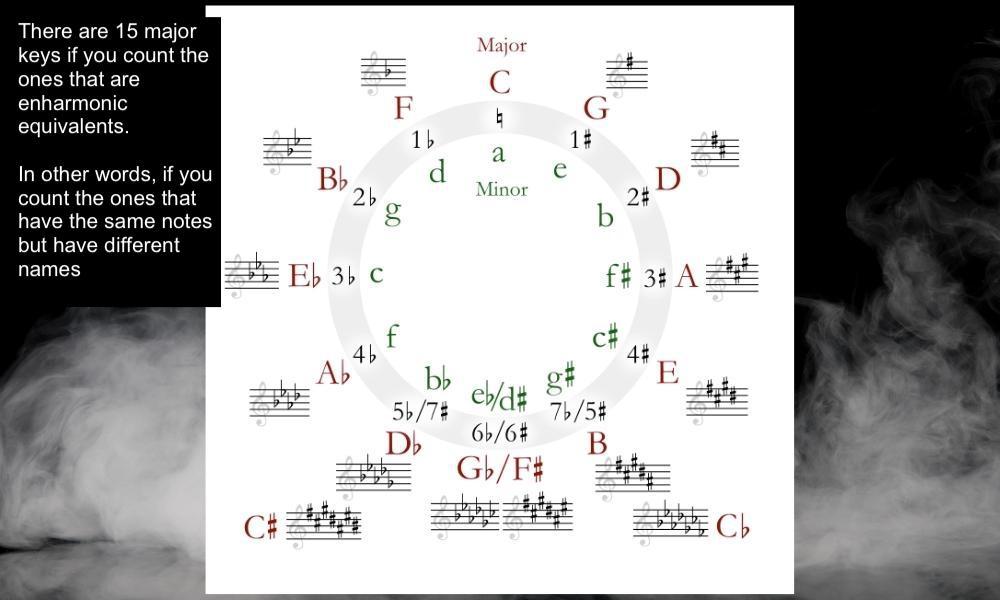
You must select your song’s musical key carefully. Choosing a key for your song will tell you a lot about the song’s structure and composition. The scale, the tonic, the bassline, and the harmonic and vocal options you’ll have all depend on the key you’ll pick.
So, first, you’ll pick a Major scale or key. In this case, you’ll need to find all the Major scales. As you learned the Major scale pattern, now, you can pick a note and build that pattern upon that fundamental note. For example, let’s take G:
Whole-step (G-A), whole-step (A-B), half-step (B-C), whole-step (C-D), whole-step (D-E), whole-step (E-F#), half-step (F#-G)
2) Find All the Chords in That Scale
After picking a Major scale or Major key, the next step is to find all the chords in that scale. Again, you can easily find various charts on Google. But apart from that, remembering the modes and key of chords can be helpful in developing your musicianship skills.
For example, let’s find all the chords of the G Major scale:
| I | ii | iii | IV | V | vi | vii |
|---|---|---|---|---|---|---|
| G Major | A Minor | B Minor | C Major | D Major | E Minor | F# Dim |
3) Find the I-IV-V (Tonic, Subdominant, Dominant)
It’s also very easy to find. All you have to do is select the chords under these three numbers, which are I, IV, and V.
For example, let’s find the Tonic, Subdominant, and Dominant on the same chart:
| I | ii | iii | IV | V | vi | vii |
|---|---|---|---|---|---|---|
| G Major | A Minor | B Minor | C Major | D Major | E Minor | F# Dim |
4) Play Them On Your Instrument or Learn to Play Them
In this section, you can find a quick and easy guide to playing the I-IV-V on the piano.
A) I-IV-V Chords On The Piano
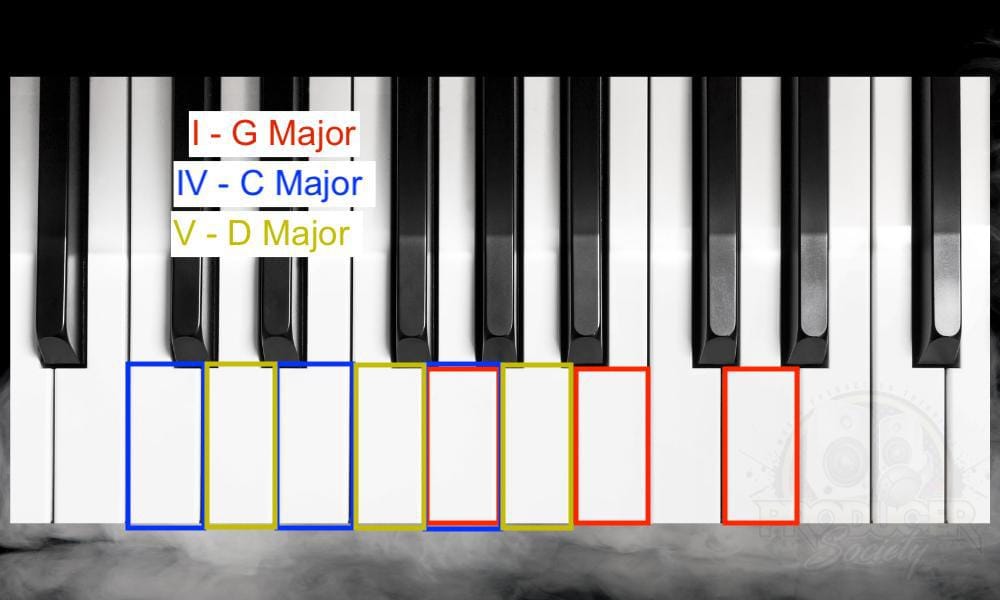
The C major triad is I. You play it with your right hand. The thumb plays C, the middle finger plays E, and the pinky plays G. Then you’ll go on to the IV chord.
Move your pinky and middle finger up one white key while keeping your thumb on C. Your pinky will be on A and your middle finger on F. Practice it back and forth after learning the maneuver.
V is the G chord. Move your thumb, middle finger, and pinky one step up the chord form you have. Your thumb will be on D, your middle finger on G, and a pinky on B. Then practice the transitions between these three chords. If you want to learn this on the guitar, my article on Traveling Guitarist will help you.

5) Use Different Voicings, Extensions, and Inversions To Make The Chords More Interesting

Applying extended chords, inversions, and add-chords will make your composition more interesting. Simple Major chords on their own are pretty stale, but an AMaj9 or a Cmin7 can sound pretty fresh.
For example, most dominant 7 chords may have 9ths easily added. So by adding a 9th to a 7th, you can get from Cm7 to F9 by modifying only one note.
In fact, the most popular method to expand on Simple Major chords is to introduce chord VI from the relative minor key. This is A minor in the key of C Major, according to the chart above. At that point, AMaj9 is the relative Major of the A minor.
Also, switching up the order of notes can make them sound a lot more interesting as well, ie, inversions. The modes of the major scale are also helpful in finding various ways to make your music a lot more interesting – and with the same chords and the same scale. The same thing can be said about inversions as well.
6) Switch Up the Order or the Arrangement To Make It Fresh
Most people don’t just use I-IV-V as it’s written because it’s so happy to the point that it’s kind of stale and lame. Arrangement techniques, inversions, and extensions, like we just talked about, are used to make things way cooler.
Sometimes, probably more like “most of the time,” people will even throw in other chords as well. If you remember, we have just discussed the primary triads’ role parallel to the role of the primary colors citing Christopher Smith’s post. Continuing the same post, he talks about adding pastel tones to primary colors for the same purpose.
With Both Related and Unrelated Chords, You Can Spice Up Your Arrangement
Consider moving away from the primary triads if you want your harmony to have some “pastel” coloring. Instead, use alternative chords, either from the key or a note or two that aren’t in the key.
For example, instead of the IV, try an ii chord which is the second minor. If the melody note sounds okay with it, try an iii or vi chord instead of an I chord.
Try adding a sixth, seventh, or ninth note to a Major triad. Instead of IV or V, try bVII to see whether it matches the melody. If any of this information escapes you, I would recommend the section down below on the C Major scale.
The C Major Scale And Western Music Theory
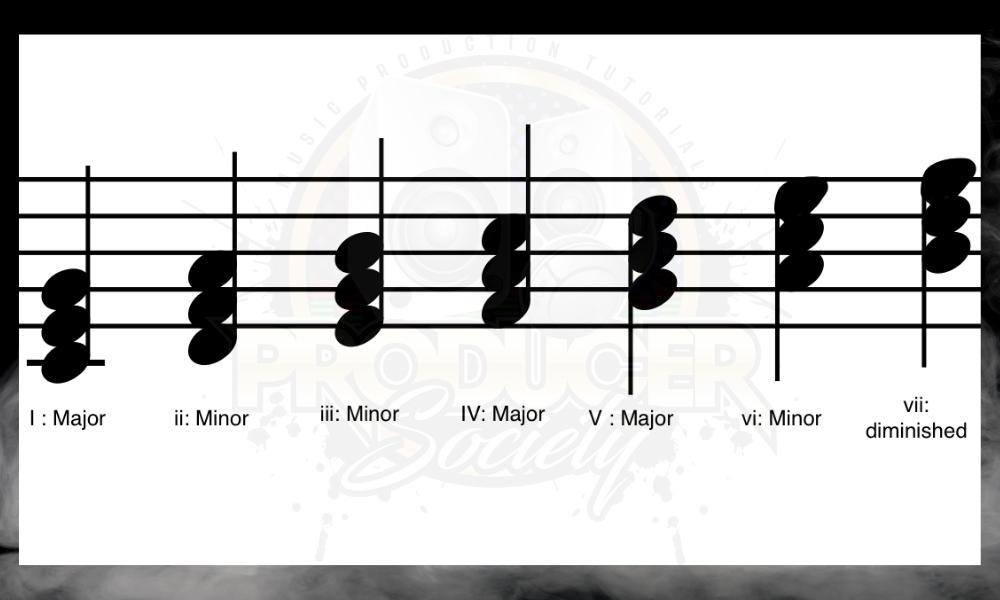
We can use the C Major Scale to reference the chords produced on and found at I, IV, and V degrees of a Major scale. as I said in my guide to music theory, C Major is at the core of Western music theory.
The feature that makes the C Major stand out is being the only key without accidentals. Above, you can find an example of the C major scale with each scale degree marked with Roman numerals.
1) The C Major Scale Is The Default Scale of Western Music Theory
According to Curtis Lindsay, because of medieval vocal music’s format, C Major has always been the key without accidentals. These practices were already in place when keyboard layouts were first invented and standardized. It was also before the major and minor scales took their fixed shape.
As I stated in my guide on why the piano is a good instrument to learn, playing in C Major is one of the easier keys because of the lack of accidentals and black keys. Apparently, Chopin often put C major last when he taught scales and exercises to students. He thought it was the easiest key to play.
Many wind instruments in the orchestra read transposed music. This means the written key of C corresponds to the sounding key of whatever pitch is naturally tuned. The reason is that the C Major is the simplest key to read.
2) The Intervals In a Scale Determine Whether It Is Major or Not
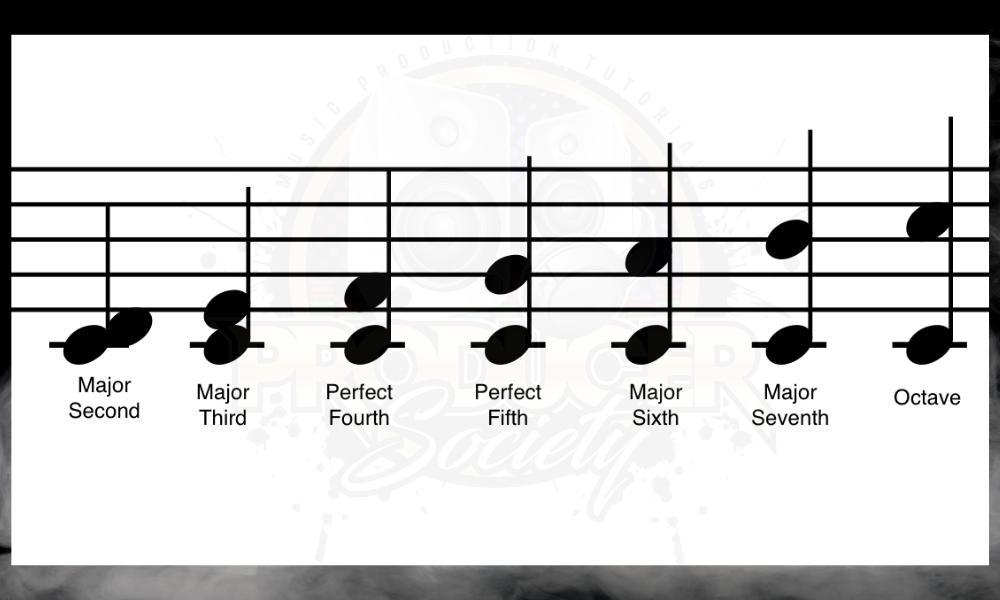
The first point to learn about the subject is that Major scales create a more cheerful atmosphere while minor scales sound more melancholic. The intervals that make the Major scale cause this effect.
A scale is essentially a pattern of whole and half steps (tones and semitones) inside an octave. It is a pattern of any succession of notes, tones, or intervals within an octave in music. The pattern for the C Major scale and for any other Major scale is:
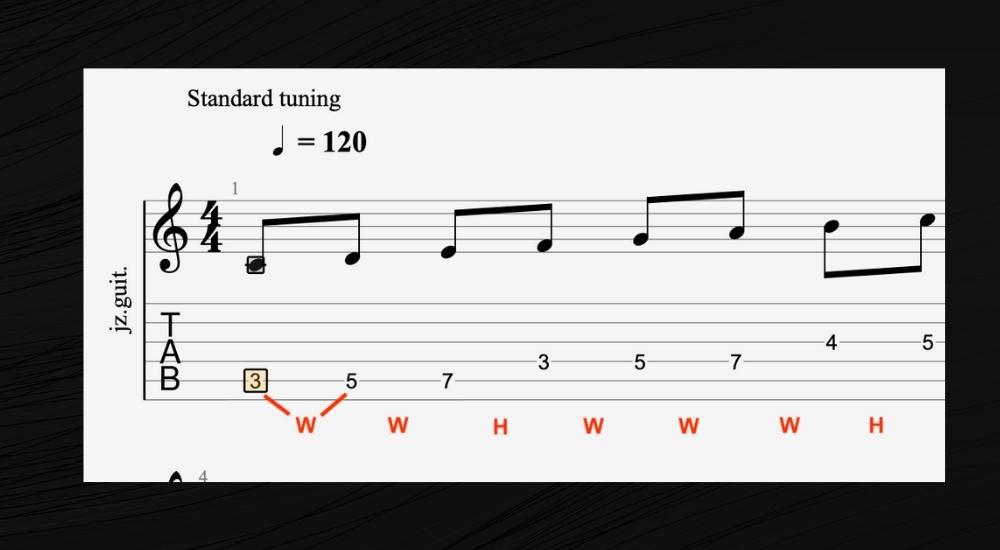
This pattern works the same for any Major scale. If you want to learn the Major scale pattern and hear the differences between the intervals, it’s time to sit at a piano or keyboard.
To play only the white notes, start on a C and progress up to the C above. This will produce the ascending C Major scale. Likewise, you’ll discover the descending C Major scale if you go back down.
3) Modes Will Help You To Understand How Certain Sounds Come from the Major Scale
The modes, which include the Major and minor scales, have seven notes per octave. Even the arrangement of the notes is the same; the only difference is that the notes begin at a different interval. For example, the Ionian mode is the mode of the Major scale, but the Aeolian mode is the mode of the natural minor scale.
Take the time to learn how a scale of notes converts into a key of chords if you don’t know how. The image I shared earlier has the same information. In the image below, I’ll show you the modes of the C Major scale on the guitar and in standard notation. The detailed chart after has a lot more information.
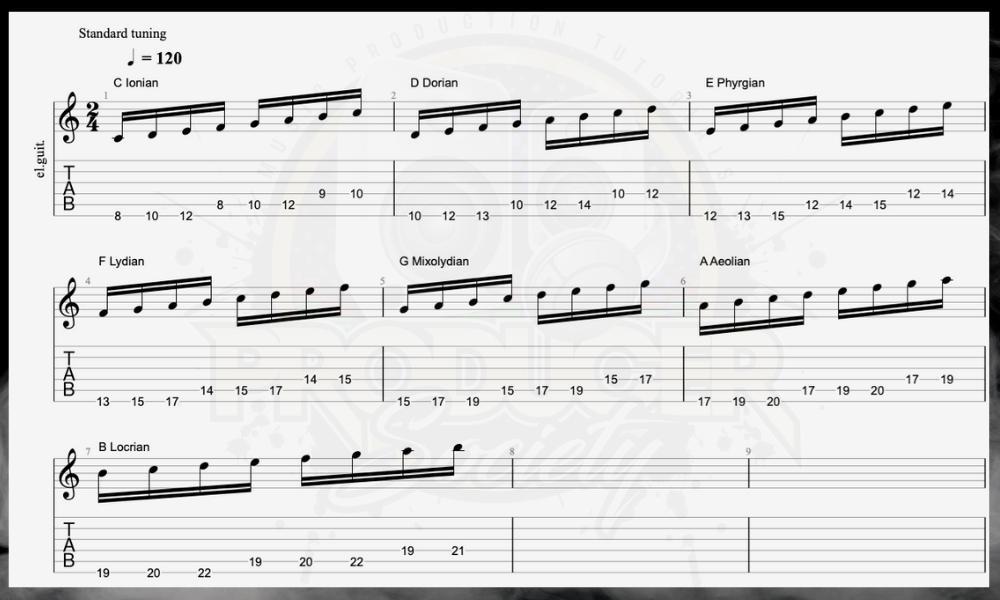
| The Name of the Mode | The Note of the Major Scale It Starts On | The Modal Chords (From most important to least) |
Notes Starting on C | Chords in C |
|---|---|---|---|---|
| Ionian | 1st Note | I, IV, V ii, iii, vi viiº |
C, D, E, F, G, A, B, | C, F, G Dm, Em, Am Bdim |
| Dorian | 2nd Note | i, ii, v VII, III, IV viº |
C, D, Eb, F, G, A, Bb, | Cm, Dm, Gm, Bb, Eb, F Adim |
| Phrygian | 3rd Note | i, iv, vii II, III, VI vº |
C, Db, Eb, F, G, Ab, Bb, C | Cm, Fm, Bbm Db, Eb, Ab Gdim |
| Lydian | 4th Note | I, II, V iii, vi, vii ivº |
C, D, E, F#, G, A, B, | C, D, G Em, Am, Bm F#dim |
| Mixolydian | 5th Note | I, IV, VII ii, v, vi iiiº |
C, D, E, F, G, A, Bb, | C, F, Bb Dm, Gm, Am Edim |
| Aeolian | 6th Note | i, iv, v III, VI, VII iiº |
C, D, Eb, F, G, Ab, Bb | Cm, Fm, Gm Eb, Ab, Bb Ddim |
| Locrian | 7th Note | iº iii, iv, vii II, V, VI |
C, Db, Eb, F, Gb, Ab, Bb, | Cdim Ebm, Bbm, Fm Db, Gb, Ab |
The Scale Degrees of the Major Scale
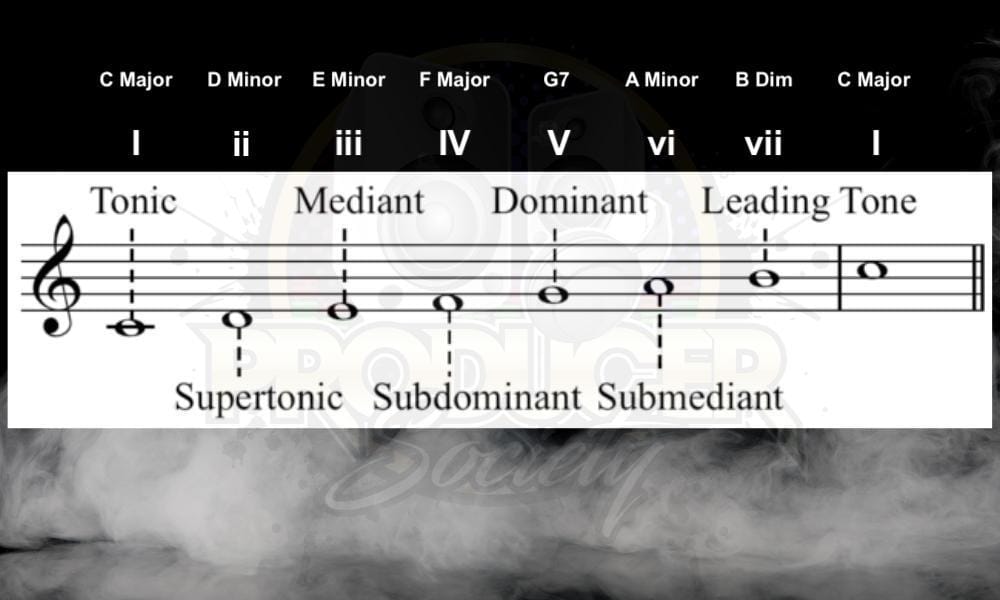
Understanding and memorizing the names of the scale degrees certainly wouldn’t hurt. This helps us understand how a scale works. You can take it as a numerical approach to describing scales. Once you know the concept, everything about the scales makes sense.
The Major Scale Degrees in C:
The initial degree is C – C is the tonic.
The second degree is D – D is the supertonic.
The third degree is E – E is the mediant.
The fourth degree is F – F is the subdominant.
The fifth degree is G – G is the dominant.
The sixth degree is A – A is the submediant.
The seventh degree is B – B is the leading tone.
Now, it’s time to understand better the scale degrees of the Major scale one by one. This will explain to you why certain sounds are happy and consonant, and why others are unhappy and dissonant.
Tonic
The tonic is the Major scale’s fundamental degree. The tonic note gives the scale its name and acts as its tonal center of gravity. In other words, in every kind of scale degree, the tonic is the home note and the conclusion point.
Supertonic
The supertonic scale, on the other hand, is a note that’s just one step removed from the tonic. For that reason, it sounds great over almost any note in the scale from which it’s derived which is something Andrew Huang said in his video too.
You can sit on the 2nd note for a while and then come back to the tonic and it’ll sound perfect. And the same thing goes for the other chords too. The supertonic is a big part of music right now because of its Dorian vibe, which seems to be so popular due to the influence of R&B.
Mediant
Mediant is a Latin word that means “middle.” You can wonder why it is called so even if it’s not in the middle. However, the term indicates the middle of the first-degree triad. A mediant, or middle note, appears in all major and minor chords.
The mediant is often used as a way of introducing a bit of sadness into a major chord progression. For example, if you were to throw in the iii chord into an I-IV-V progression, you would get more of a melancholy vibe. Sound Signals Studio demonstrated this really well.
Subdominant
The term “subdominant” was developed as its scale degree is one note below the dominant. The term also indicates that the perfect fourth, when you look at it from below the tonic, becomes the perfect fifth.
The subdominant can serve many purposes, but due to the intervals that it forms in relation to the tonic and dominant chord, it tends to sound like it can go in any direction, either up to the dominant or back down to the tonic.
Dominant
The dominant in a Major scale is the fifth degree. You can take the dominant as the second most significant scale degree after the tonic. The majority of classical music is built around the resolution of the V-I.
This resolution from dominant to tonic is also quite popular in today’s music. The reason for this has to do with the number of half steps and whole steps between the dominant chord and the tonic chord.
Submediant
The sixth scale degree is referred to as the submediant. The term submediant is derived from the same source as the term subdominant. What’s special about the sub-mediant chord is that it’s also the Aeolian mode, or in other words, the relative minor of the key.
If C Major is the Tonic, A Minor is the sub-mediant, and the relative minor too. Going from the tonic of the key up to the natural relative minor (I-vi) will always sound good. I think this might actually be my favorite chord progression, although, it’s only two notes or chords.
Leading Tone
The leading tone naturally gravitates toward the tonic as it is a half-step below. The leading tone is one minor second lower than the tonic, whereas the supertonic is one major second higher than the tonic.
If you play the diminished chord built on the B of the C Major scale, you’ll notice there is a strong tendency for it to go back to the tonic. That’s why we call it the leading tone. It’s working super hard to get us back home.
There Are Other Happy Chord Progressions
I-IV-V chord progression is the happiest progression but it’s not the only happy progression. There are many other progressions that can sound super happy.
i-VI-III-VII starts with minor but the following Major chords create a cheerful atmosphere.
I-vi-IV-V was one of the most popular chord progressions of the 50s.
i-IV-VI-v is a progression that you can be familiar with especially from Bob Marley’s songs.
I-III-IV is another popular happy chord progression.
One thing I should say is that we don’t always need to use only major chords to express happiness. I would recommend Mark Sarnecki’s books on Amazon if you’re interested in learning more.
![Mark Sarnecki's Complete Elementary Rudiments - Why Do Some Pianos Start With A C and Not an A [ANSWERED]](https://producersociety.com/wp-content/uploads/2022/03/Mark-Sarneckis-Complete-Elementary-Rudiments-Why-Do-Some-Pianos-Start-With-A-C-and-Not-an-A-ANSWERED-1.jpg)
Other Articles You May Be Interested In
- Does Hip-Hop Have Harmony
- Major vs Minor Pentatonic Scales
- What’s the Difference Between A Key and Time Signature
- What is the Darkest Scale?
Important Thing to Note About the “Happiest” Chord Progression
1) What is the Happiest Depends on Context and Taste
Obviously, what is considered the “happiest” chord progression depends largely on context, how the chords are being used, arrangement, instruments, tempo, time signature, etc.
It is possible to observe that the I-IV-V chord is not only used to give an extremely happy feeling. You can consider the songs I shared above as proof of this.


 Written By :
Written By : 